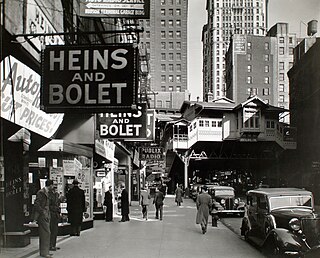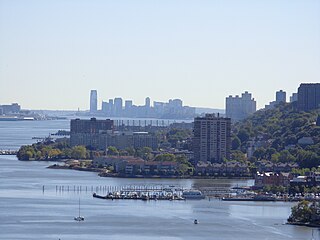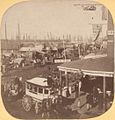
North River is an alternative name for the southernmost portion of the Hudson River in the vicinity of New York City and northeastern New Jersey in the United States. The entire watercourse was known as the North River by the Dutch in the early seventeenth century; the term fell out of general use for most of the river's 300+ mile course during the early 1900s. The name remains in limited use among local mariners and others and on some nautical charts and maps. The term is also used for infrastructure on and under the river, such as the North River piers, North River Tunnels, and the North River Wastewater Treatment Plant.

The Kearny Connection is a railroad junction in Kearny, New Jersey that allows passenger trains from New Jersey Transit's Morris and Essex Lines to enter/leave Amtrak's Northeast Corridor (NEC) and travel to and from New York Penn Station. The junction, which opened in 1996 and utilizes Swift Interlocking, is nearby the Sawtooth Bridges.

For the purposes of this article, the Jersey City area extends North to Edgewater, South to Bayonne and includes Kearny Junction and Harrison but not Newark. Many routes east of Newark are listed here.

Paulus Hook is a community on the Hudson River waterfront in Jersey City, New Jersey. It is located one mile across the river from Manhattan. The name Hook comes from the Dutch word "hoeck", which translates to "point of land." This "point of land" has been described as an elevated area, the location of which today is bounded by Montgomery, Hudson, Dudley, and Van Vorst Streets.

The Pennsylvania Railroad Station was the intermodal passenger terminal for the Pennsylvania Railroad's (PRR) vast holdings on the Hudson River and Upper New York Bay in Jersey City, New Jersey. By the 1920s the station was called Exchange Place. The rail terminal and its ferry slips were the main New York City station for the railroad until the opening in 1910 of New York Pennsylvania Station, made possible by the construction of the North River Tunnels. It was one of the busiest stations in the world for much of the 19th century.

The Central Railroad of New Jersey Terminal, also known as Communipaw Terminal and Jersey City Terminal, was the Central Railroad of New Jersey's waterfront passenger terminal in Jersey City, New Jersey. The terminal was built in 1889, replacing an earlier one that had been in use since 1864. It operated until April 30, 1967.

Pavonia Terminal was the Erie Railroad terminal on the Hudson River situated on the landfilled Harsimus Cove in Jersey City, New Jersey. The station opened in 1861 and closed in 1958 when the Erie Railroad moved its passenger services to nearby Hoboken Terminal. The New York, Susquehanna and Western Railway also ran commuter trains from the terminal and various street cars, ferries and the underground Hudson and Manhattan Railroad serviced the station. The station was abandoned in 1958 and demolished in 1961. The site was eventually redeveloped into the Newport district in the late 20th century.

Bergen Hill refers to the lower Hudson Palisades in New Jersey, where they emerge on Bergen Neck, which in turn is the peninsula between the Hackensack and Hudson Rivers, and their bays. In Hudson County, it reaches a height of 260 feet.

Pavonia was the first European settlement on the west bank of the North River that was part of the seventeenth-century province of New Netherland in what would become the present Hudson County, New Jersey.

Weehawken Terminal was the waterfront intermodal terminal on the North River in Weehawken, New Jersey for the New York Central Railroad's West Shore Railroad division, whose route traveled along the west shore of the Hudson River. It opened in 1884 and closed in 1959. The complex contained five ferry slips, sixteen passenger train tracks, car float facilities, and extensive yards. The facility was also used by the New York, Ontario and Western Railway. The terminal was one of five passenger railroad terminals that lined the Hudson Waterfront during the 19th and 20th centuries; the others were located at Hoboken, Pavonia, Exchange Place and Communipaw, with Hoboken being the only one still in use.

The Cortlandt Street station was an express station at Greenwich Street on the demolished IRT Ninth Avenue Line in Manhattan, New York City. It was built as a replacement for the original southern terminus at Dey Street. It had three tracks, one island platform and two side platforms. It was served by trains from the IRT Ninth Avenue Line. It closed on June 11, 1940. The next southbound stop for all trains was Rector Street. The next northbound local stop was Barclay Street. The next northbound express stop was Warren Street.

The Hudson Waterfront is an urban area of northeastern New Jersey along the lower reaches of the Hudson River, the Upper New York Bay and the Kill van Kull. Though the term can specifically mean the shoreline, it is often used to mean the contiguous urban area between the Bayonne Bridge and the George Washington Bridge that is approximately 19 miles (31 km) long. Historically, the region has been known as Bergen Neck, the lower peninsula, and Bergen Hill, lower Hudson Palisades. It has sometimes been called the Gold Coast.

The Battery Park City Ferry Terminal, is a passenger ferry terminal in Battery Park City, Manhattan, serving ferries along the Hudson River in New York City and northeastern New Jersey. It provides slips to ferries, water taxis, and sightseeing boats in the Port of New York and New Jersey.

The Chambers Street Ferry Terminal was the Erie Railroad's main ferry slip on Manhattan and the point of departure and embarkation for passengers in New York City. The terminal was one of several operated by ferry companies and railroads that lined the western shore of Manhattan during the 19th and 20th centuries. The Pavonia Ferry operated for over 100 years from the terminal, which was demolished about three years after the Erie Railroad stopped its ferry service to Chambers Street in December, 1958.

Liberty Street Ferry Terminal or Liberty Street Terminal was the Central Railroad of New Jersey's passenger ferry slip in lower Manhattan, New York City and the point of departure and embarkation for passengers travelling on the Central Railroad of New Jersey, Baltimore and Ohio Railroad, Reading Railroad and the Lehigh Valley Railroad from the Communipaw Terminal across the Hudson River in Jersey City.

The Jersey City Ferry was a major ferry service that operated between Jersey City in New Jersey and Cortlandt Street in lower Manhattan for almost 200 years (1764-1949). The ferry was notable for being the first to use steam power which began in 1812. The ferry's history was closely tied to the Pennsylvania Railroad's station in Jersey City at Exchange Place, which gradually fell into disuse after the railroad opened the North River Tunnels and Penn Station in 1910. Ferry service from lower Manhattan to Jersey City continued via the even older Communipaw ferry which operated from the adjacent Liberty Street Ferry Terminal until this service was also discontinued in 1967. In 1986 ferry service was revived and today it is operated by New York Waterway.
The Communipaw Ferry was a major ferry service that operated between the village of Communipaw and Lower Manhattan, New York. The ferry began operations in 1661 after the Colonial Dutch administrators of New Amsterdam granted a charter to operate the ferry. soon after the establishment of Bergen atop Bergen Hill. It was the first reported ferry service established across the Hudson River and it remained active up until 1783 when New York City was captured by the British.
Peter Mesier Sr. was an American merchant and politician who served as alderman of New York City's West ward from 1759 to 1763.





















